|
Posted on 06/04/2004 12:06:09 AM PDT by snippy_about_it
|
|
 are acknowledged, affirmed and commemorated.
|

| Our Mission: The FReeper Foxhole is dedicated to Veterans of our Nation's military forces and to others who are affected in their relationships with Veterans. In the FReeper Foxhole, Veterans or their family members should feel free to address their specific circumstances or whatever issues concern them in an atmosphere of peace, understanding, brotherhood and support. The FReeper Foxhole hopes to share with it's readers an open forum where we can learn about and discuss military history, military news and other topics of concern or interest to our readers be they Veteran's, Current Duty or anyone interested in what we have to offer. If the Foxhole makes someone appreciate, even a little, what others have sacrificed for us, then it has accomplished one of it's missions. We hope the Foxhole in some small way helps us to remember and honor those who came before us.
|
 The most famous helicopter in the world is the Bell UH-1 Iroquois, most commonly referred to as the "Huey." The Huey, which first flew in 1956, serves in front-line service in the U.S. military and the militaries of many nations and will continue to do so for many years to come. It earned its fame during the Vietnam War and has been featured in many war movies, including Apocalypse Now and Platoon, as well as in numerous action adventure films.  The Huey has several distinctive characteristics, including its rounded nose, its twin-bladed rotor, and the loud "whomp whomp" sound it makes in flight. It is a particularly noisy helicopter because, when in forward flight, the tip of the advancing rotor blade breaks the speed of sound, creating a small sonic boom.  Clic on the Helicopter to hear a U H-1 Huey Sound bit [Huey.wav], 26k, 3 seconds. The first helicopters, such as the Sikorsky R-4 and S-51, were powered by piston engines. By the early 1950s, turbine engines were being used in many fixed-wing aircraft and helicopter designers began to consider using them for helicopters. Turbines were lightweight and provided more power than piston engines, but were more expensive. The first Bell helicopter to use a turbine engine was a modified Model 47 designated the XH-13F and flown in October 1954. In early 1955, the Army awarded Bell a contract to develop the next generation turbine-powered medevac helicopter, designated the XH-40 and soon named the Model 204. The first XH-40 flew on October 22, 1956. Two more prototypes were built in 1957, and eighteen more YH-40 service test aircraft in 1958.  Bell actively marketed the craft for more than the narrow medevac role, and the pre-production aircraft proved so popular among servicemen who were used to piston-powered aircraft that the Army soon ordered even more of the craft. The Huey was the first turbine-equipped U.S. helicopter to go into production.Production model HU-1As entered service with the 101st Airborne at Fort Lewis, Washington. Although they were intended for evaluation only, the Army quickly pressed them into operational service. The helicopter was originally designated the HU-1A, which is where it received its name "Huey." The official U.S. Army designation Iroquois (Army helicopters are traditionally given Native American names) was almost never used in practice. The HU-1B was equipped with revised main rotor blades and could carry seven passengers. These versions were redesignated UH-1A and UH-1B respectively, in 1962. A UH-1C version with a more powerful engine soon followed.  The U.S. Army "Dustoff" helicopter, the Bell UH-1 Huey, received its nickname for the dirt that it kicked up as it took off and landed. The Huey saw combat in Vietnam in 1962, first as a troop transport and medevac helicopter and later as an armed assault helicopter used to protect troop transports. The Army was just beginning to develop its "air mobility" concept. Instead of fighting an enemy along established front lines, troops would now be taken into and removed from combat by helicopter and dropped at key strategic positions such as enemy escape routes. The nimble, capable Hueys flew escort with larger, slower Piasecki H-21 Flying Bananas.  Piasecki This was a revolutionary form of combat that was not without its problems. As soon as the Viet Cong chose to hold their ground rather than flee at the arrival of the helicopters, they discovered the helos could be brought down with small arms fire. The H-21 proved particularly vulnerable. During one disastrous battle at Ap Bac near Saigon in January 1963, four H-21s and one armed Huey were lost to enemy fire. Nevertheless, the U.S. Army soon fully embraced air mobility, but helicopters remained vulnerable to ground fire. By 1973, approximately 2,500 Hueys had been lost in Vietnam, roughly half to combat and the rest to operational accidents.  Several thousand of the early Huey variants were produced. Beginning in 1963, the U.S. Army ordered the first of the improved Model 205/UH-1D Hueys. Its primary modification was the addition of an enlarged and stretched main cabin and more powerful engine to boost carrying capacity. More than 2,500 of this model entered service with the U.S. armed forces, culminating in the UH-1H version. A single Textron Lycoming T53-L-13 turboshaft engine with 1,400 shaft horsepower (1,044 kilowatts) powered the UH-1H. The craft was 41 feet 9 inches (12.7 meters) long, 14 feet 5 inches (4.4 meters) high, and had a rotor diameter of 48 feet (14.6 meters). It weighed 5,210 pounds (2,363 kilograms) empty, had a maximum speed of 127 miles per hour (204 kilometers per hour) and a range of 276 nautical miles (511 kilometers). The U.S. Marine Corps wanted a more powerful version of the Huey equipped with two engines. The Marines were concerned that an engine failure over water would result in a crash. Helicopters are notoriously difficult aircraft to escape from, for they immediately turn upside down upon hitting the water. In 1968, Bell proposed the first twin-engine Huey. The U.S. Air Force took delivery of the first aircraft, designated UH-1N, in 1970, and it soon became the standard utility helicopter of the Marine Corps. It was also exported in large numbers and eventually manufactured in Canada. The UH-1N could be easily distinguished from the earlier models by its slightly pointed nose. Despite its two engines, the UH-1N was slightly slower than the UH-1H. An armed helicopter called the HueyCobra (often simply called the Cobra) used the engine, rotors, and many other systems from the Huey. It had a slender fuselage carrying a two-person crew, and numerous weapons.  The Huey was enormously successful for three reasons. First, it achieved an ideal mix of cabin room, speed, and lifting capability. Earlier piston-engine helicopters simply lacked enough power for many military missions. Second, the Huey proved to be a rugged and reliable helicopter in service. In addition, large military orders enabled Bell to offer the Huey both commercially and overseas at an attractive price. Bell also built commercial versions of the military Hueys beginning in 1960, and developed upgraded models such as the 214 and 412 for military export and civilian use. The Model 412 was equipped with a four-bladed rotor and more powerful engines and was still being produced at Bell Helicopter Canada in 2000.  Bell and licensed firms like Italy's Agusta (eventually bought by Bell) have built more than 15,000 Hueys. It is the most numerous helicopter ever built and the most numerous aircraft built since 1945 except for the Soviet-era Antonov An-2 biplane transport. The Huey is operated by more than 60 air forces throughout the world in a wide variety of roles, everything from VIP transport to flying ambulance to attack helicopter. It has continued in service well past the five decades since the first Huey lifted off the ground. Dwayne A. Day The most widely used military helicopter, the Bell UH-1 series Iroquois, better known as the "Huey", began arriving in Vietnam in 1963. Before the end of the conflict, more than 5,000 of these versatile aircraft were introduced into Southeast Asia. "Hueys" were used for MedEvac, command and control, and air assault; to transport personnel and materiel; and as gun ships. Considered to be the most widely used helicopter in the world, with more than 9,000 produced from the 1950s to the present, the Huey is flown today by about 40 countries.  Bell (model 205) UH-1D (1963) had a longer fuselage than previous models, increased rotor diameter, increased range, and a more powerful Lycoming T53-L-11 1100 shp engine, with growth potential to the Lycoming T53-L-13 1400 shp engine. A distinguishing characteristic is the larger cargo doors, with twin cabin windows, on each side. The UH-1D, redesigned to carry up to 12 troops, with a crew of two, reached Vietnam in 1963. The UH-1D has a range of 293 miles (467km) and a speed of 127 mph (110 knots). UH-1Ds were build under license in Germany. UH-1D "Hueys" could be armed with M60D door guns, quad M60Cs on the M6 aircraft armament subsystem, 20mm cannon, 2.75 inch rocket launchers, 40mm grenade launcher in M5 helicopter chin-turret, and up to six NATO Standard AGM-22B (formerly SS-11B) wire-guided anti-tank missiles on the M11 or M22 guided missile launcher. The UH-1D could also be armed with M60D 7.62mm or M213 .50 Cal. pintle-mounted door guns on the M59 armament subsystem. The MedEvac version UH-1V could carry six stretchers and one medical attendant. Bell (model 205A-1) UH-1H (1967-1986) was identical to the UH-1D but was equipped with an upgraded engine that allowed transport of up to 13 troops. The UH-1H has a two-bladed semi-rigid seesaw bonded all metal main rotor and a two-bladed rigid delta hinge bonded all metal tail rotor. The UH-1H is powered by a single Lycoming T53-L-13B 1400 shp turboshaft engine. More UH-1H "Hueys" were built than any other model. The UH-1H was licensed for co-production in the Republic of China (Taiwan) and in Turkey. UH-1H "Nighthawk" was equipped with a landing light and a pintle mounted M134 7.62mm "minigun" for use during night interdiction missions. The AH-1G Cobra was often flown on night "Firefly" missions using the UH-1H "Nighthawk" to locate and illuminate targets.  The Bell Huey UH-1H was an improved model that had an enlarged main cabin and more powerful engine.  The UH-1N is a twin-piloted, twin-engine helicopter used in command and control, resupply, casualty evacuation, liaison and troop transport. The Huey provides utility combat helicopter support to the landing force commander during ship-to-shore movement and in subsequent operations ashore.he aircraft can be outfitted to support operations such as command and control with a specialized communication package (ASC-26), supporting arms coordination, assault support, medical evacuation for up to six litter patients and one medical attendant, external cargo, search and rescue using a rescue hoist, reconnaissance and reconnaissance support, and special operations using a new navigational thermal imaging system mission kit.   As the United States Marine Corps (USMC) prepared to enter the 21st century, one of its top priorities is the H-1 Upgrade Program. This program encompasses the remanufacture of all light/attack helicopters in order to extend their service-life to the year 2020. The H-1 Upgrade (UH-1Y/AH-1Z) program replaces the current two-bladed rotor system on the UH- 1N and AH-1W aircraft with a new four-bladed, all-composite rotor system coupled with a sophisticated, fully integrated, state-of the-art cockpit.  The goal of the USMC H-1 Upgrades Program is to achieve a platform that meets the growing needs of the Marine Corps. The 4BW and 4BN will be an upgraded version of the current AH-1W and UH-1N Helicopters. The 4BW and 4BN (snippy update: redesignated to AH-1Z and UH-1Y, respectively (formerly referred to as "4BW" and "4BN," respectively). ) will share a common engine, Auxiliary Power Unit, four-bladed main and tail rotor system, transmission, drive train, and tail boom. The purpose of these modifications is to achieve commonality in both aircraft, thereby reducing logistical support, maintenance workload, and training requirements. The replacement of the two bladed rotor system with a common four bladed rotor system will achieve improved performance, reliability, and maintainability. The addition of an infrared suppresser to the aircraft will improve survivability. The 4BW will also include a newly developed cockpit, which will result in nearly identical front and rear cockpits that simplify operator and maintainer training and maintenance.  Primary function Utility helicopter Manufacturer Bell Helicopter Textron Power plant Pratt and Whitney T400-CP-400 Power Burst: 1290 shaft horsepower (transmission limited) Continuous: 1134 shaft horsepower (transmission limited) Length 57.3 feet (17.46 meters) Height 14.9 feet (4.54 meters) Rotor Diameter 48 feet (14.62 meters) Speed 121 knots (139.15 miles per hour) at sea level Ceiling 14,200 feet (4331 meters) (limited to 10,000 feet (3050 meters) by oxygen requirements) Maximum takeoff weight 10,500 pounds (4,767 kilograms) Range 172 nautical miles (197.8 miles) Crew Officer: 2 Enlisted: 2 Armament M-240 7.62mm machine gun or GAU-16 .50 caliber machine gun or GAU-17 7.62mm automatic gun All three weapons systems are crew-served, and the GAU-2B/A can also be controlled by the pilot in the fixed forward firing mode. The helicopter can also carry two 7-shot or 19-shot 2.75" rocket pods. Introduction date 1971 Unit Replacement Cost $4,700,000 Marine Corps Inventory 107      |

I spent lots of time in "Novembers" as we called the UH-1N. They were subject to quite a bit of low frequency vibration in the back. The pilots didn't feel it as much as I because they were eight feet farther away from the engines and had better seats. I was usually sitting on a bench in the right door with my back right up against the gear box. Nothing worse than 90 minutes of freezing cold, vertigo, and low frequency vibration.
The Battle of Midway was the turning point of World War II in the Pacific, leading to eventual Allied victory. At the very start of that fateful conflict came this ominous confrontation. At 7:00 A.M. on June 4,1942, Grumman TBF Avengers of the VT-8 squadron on their maiden combat flight were attacked by Japanese Mitsubishi A6M Zero fighters. A-T-I was the only Avenger to survive the encounter.
They were subject to quite a bit of low frequency vibration in the back.
It's tough work beating the air into submission. ;-)
The local ANG group has a bunch of these here in the Twin Cities and you can always hear them coming from a long way off.
Whenever I hear them, for some reason I always want to hum "Ride of the Valkyries" - LOL

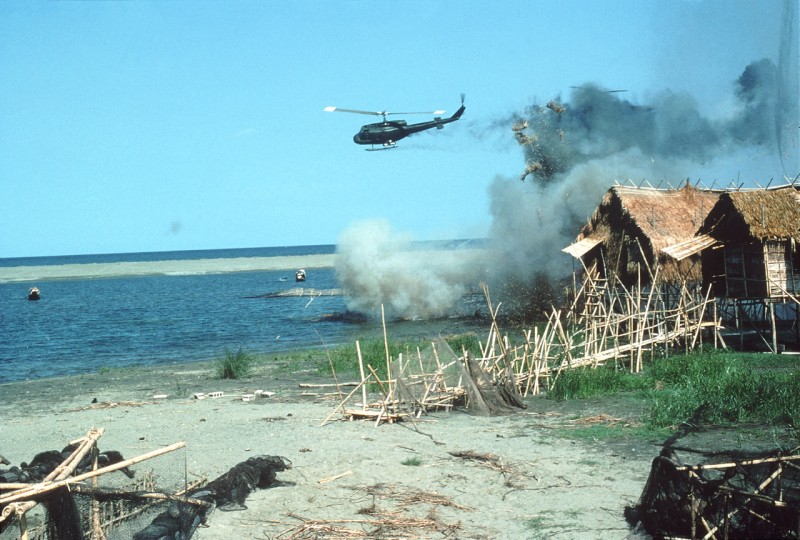
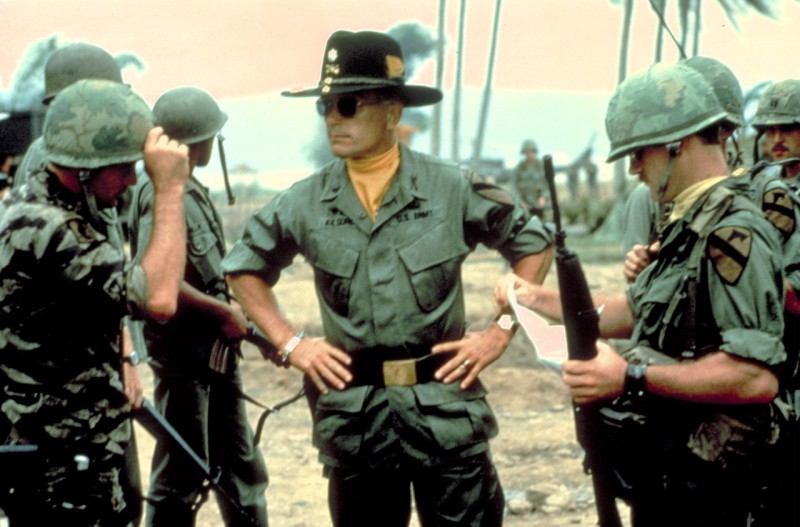
I love the smell of Napalm in the morning. The smell, you know that gasoline smell. Smells like victory.
Our middle school reprts having computer problems. The city clerk said they reprt that their computers are "messed up".
There was also a 10 hour power outage in Marlow yesterday. Apparently a bullsnake snuck into the power station and damaged some equipment. This was a ten hour power outage from 2 AM to around noon. Western Farmers Electric has provided a temporary substation for the city until they get theirs fixed which should be about two or three weeks.
We did get about a half inch of rain from the storms on Wednesday.
Nothing worse than 90 minutes of freezing cold, vertigo, and low frequency vibration.
PAAARTY!
I was mentioning to Snippy the other day that there seems to be more tornados than usual.
Good morning good sir!
Everytime I get a chance to crawl around in one I feel right at home.
What a work horse.
Btw... We've got an airshow at our local airport here this weekend. Already with a C-47 (DC-3) in, and some Mustangs coming in tomorrow.
Coming in on a wing and a prayer...
|
Air Power |
The development of the Bell AH-1 "Huey" Cobra dates back to the 1960's when the need was recognized for a light fast armed escort helicopter designed specifically to carry weapons and be able to target them very accurately. The Cobra traces its lineage from the UH-1 Huey and was originally developed for the US Army in the mid-sixties. The original Cobra retained the Huey's engine, transmission, and other major parts, but replaced the Huey's bulky fuselage with a thin profile fuselage with tandem seating. Bell Helicopter (now Bell Helicopter Textron) had already evolved the first attack helicopter design, based on the use of UH-1 Huey dynamics (rotors, drives, engine) with a new fuselage. Bell also built a company-sponsored, scaled-down prototype using H-13/Model 47 series components, its Model 207 Sioux Scout.
The Lockheed AH-56A Cheyenne was designed to meet the US Army's requirement for the Advance Aerial Fire Support System (AAFSS), a program which began in 1964. Lockheed rolled-out the first prototype on 03 May 1967. While the Army went forward with its sophisticated AAFSS program to provide an attack helicopter, Bell proceeded with another company-sponsored prototype, Model 209, using the Huey dynamics and an airframe similar to the initial design. Bell Helicopter-Textron began design of the model 209 AH-1 "Huey" Cobra in 1965 as a successor to it's UH-1B/UH-1C "Huey" in the gun ship role. The result, incorporating the best features from the UH-1C "Huey", and many parts in common with the UH-1D, was the World's first attack helicopter. The 209 first flew in September 1965.
The Army wanted a small agile Advanced Attack Helicopter (AAH) with a less complicated fire control and navigation system than the AH-56A Cheyenne. The urgent need for greater armed helicopter performance in Vietnam and the success of the 209 led to Army orders for prototypes and production models of the 209 as interim attack helicopters, pending production of the AAFSS (which, finally, was never to occur). Carried over from the 209 were the slim fuselage with tandem cockpits (gunner in front of pilot), the Lycoming T-53 engine, stub wings with store stations and the under nose turret. Its retractable skid landing gear was replaced by a fixed gear. The Bell (model 209) AH-1G Cobra featured the new "540" wide-bladed rotor, and a slim fuselage, that gave it twice the speed of the UH-1B Huey. It could could loiter over the target area three times as long, and had an improved armament system over previous gun ships.
The decision to buy the Cobra, which was built primarily of Huey parts and thus a quick and relatively cheap development for Bell, created strong conflict within the Army between operators and material developers. At this time the material developers had spent years and huge amounts of money developing the advanced AH-56 Cheyenne attack and reconnaissance helicopter. After several months of discussion, the Chief of Staff of the Army called the director of Army Aviation and the Vice Chief of Staff of the Army into his office to settle the issue. He asked the director of Army Aviation Colonel George P. Seneff what the soldiers in Vietnam needed. Colonel Seneff told Chief of Staff General Harold K. Johnson and Vice Chief of Staff General Creighton Abrams that the soldiers were dying now, not in the future. They needed the Cobra. Partly based on their suggestion, General Johnson made the decision to buy the Cobra.
Bell Helicopter won the competition for an interim fast armed escort helicopter in March 1966, against the Sikorsky S-61 and the Kaman HH-2C Tomahawk. DOD contracted with Bell Helicopter, Inc. (BHI) for 1,100 AH-1G aircraft, which logged more than 1 million flight hours in Vietnam.
The original AH-1G prototype (Bell N209J) had fully retractable skids. Below is an interesting photo of N209J with a chin-mounted M197 20mm cannon, a TSU, and the TOW missile system. This is possibly a prototype of the armament subsystems that were being developed for the U.S. Marine Corps AH-1J or AH-1T configurations.
Based on his belief that Seneff accurately represented the needs of the soldiers on the ground and had a strong sense of loyalty and integrity, General Johnson also almost immediately sent Colonel Seneff to Vietnam as the first commander of the 1st Aviation Brigade. Immediately upon arriving in Vietnam, Seneff called in all aviation commanders and told them that the Army needed standardization for aviation, and that it would start right there, in Vietnam.
The AH-1G Cobra [or Snake] was first deployed to Vietnam in September 1967. The Cobra's primary mission was to give fire support to troop carrying Hueys. Its trial-by-fire introduction to service as the AH-1G in Vietnam immediately provided ground commanders with air superiority without the wait of calling in the Air Force. The narrow 38 inch wide airframe presented a much more difficult target than it's derivative, the 100 inch wide UH-1 "Huey". During the Vietnam War, the AH-1G Cobra was used extensively in a variety of missions ranging from armed escort and reconnaissance to fire suppression and aerial rocket artillery. The Cobra, or "Snake", was often used effectively when paired with an unarmed OH-6A Cayuse "Loach" or OH-58A Kiowa light observation helicopter or a UH-1H "Nighthawk".
During the early 1970s, the Army conducted a series of tests in Ansbach, Germany. The tests were to determine the suitability of air cavalry elements and the AH-1G Cobra, in particular, to operate in an antitank role in the European environment. These tests demonstrated that antiarmor helicopter teams, properly employed and trained, could achieve high ratios of armored vehicles destroyed for every missile-firing helicopter lost. Armed scout and attack helicopters--especially when operating in nap-of-the-earth and nighttime environments--clearly were shown to have the required survivability and to be viable and essential elements of conventional mid- to high-intensity warfare. Thus the way was paved for the development of the modern attack and scout helicopters and the doctrinal principles that would take Army aviation into the next century.
The AH-1G Cobra, or Snake, was armed with 2.75 inch (70mm) Folding Fin Aerial Rockets (FFARs) in M158 seven-tube or M200 19-tube rocket launchers, used so effectively at An Loc in 1972. The Cobra had a chin-turret on the M28/M28A1 armament subsystem. The chin-turret mounted the M134 7.62mm minigun and the M129 40mm grenade launcher. The AH-1G could also be armed with the M134 minigun in fixed side-mounting M18/M18A1 gun pod, and the port (left) side mounting M195 20mm automatic gun on the M35 armament subsystem. The AH-1G could also mount the XM118 smoke grenade dispenser.
Some early model AH-1G/AH-1Q Cobras mounted either two M134 miniguns or two M129 grenade launchers in a M28A1 chin-turret (TAT-141). Because of problems with the ammunition feed systems, the twin-gun configuration was discontinued. The Cobra was first employed to Vietnam with the 1st Cavalry Division (Airmobile) in August 1967. The Cobra's primary mission was to give fire support to troop carrying Hueys. The AH-1G/AH-1Q Cobras were powered by a single Lycoming T53-L-13 1400 shp turbine engine, and had a speed of 196 mph (170 knots), almost twice the speed of the UH-1 Huey. Both the AH-1G and AH-1Q Cobra used the M73 reflex sight. The Cobra performed it's job so well it was possible for the first time for Slicks and gun ships to operated as true air calvary.
The AH-1G was equipped with the CONFICS (Cobra Night Fire Control System) and the SMASH (Southeast Asia Multi-Sensor Armament Subsystem for Huey Cobra) systems to provide the Cobra with the capability of detecting, identifying, and targeting ground targets during day or night operations.
Specifications:
Contractor: Bell Helicopter TEXTRON, Inc. (Prime), General Electric, Kollsman Inc.
Power Plant: Two General Electric T700-GE-401 Turboshaft engines with 1,690 horsepower each.
Accommodations: Two seats, in tandem (pilot in rear, copilot/gunner in front)
Dimensions:
Main rotor diameter: 14.63 m
Tail rotor diameter: 02.97 m
Wing span: 03.28 m
Length: overall, rotors turning 17.68 m
Length: fuselage 13.87 m
Width overall: 03.28 m
Height: (to top of rotor head) 04.11 m
Performance :
Climb rate: 1,925 feet per minute
Maximum altitude: 14,750 feet
Maximum attainable speed: 170 knots (195 mph)
Maximum cruising speed: 152 knots (173 mph)
Range at S/L with standard fuel, no reserves: 317 nm
Armaments:
One M197 three barrel 20 mm gun (mounted under the nose with 750 round ammo container)
Underwing attachments for:
four TOW missiles, or
eight Hellfire missiles, or
one AIM-9L Sidewinder missile
Can also be equipped with Zuni rocket launchers
Countermeasures:
AN/ALE-39 Chaff system
SUU-4/1 Flare dispensers




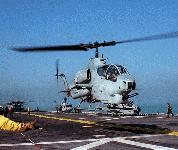
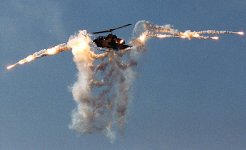
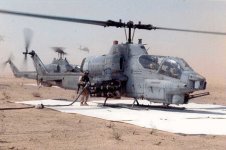
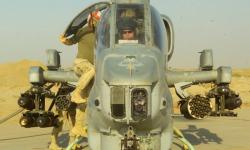
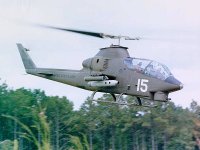
WOP,WOP,WOP! WHOOSH x 24! KABOOM! KABOOM!WOP! WOP! WOP!
free dixie,sw
Oh boy, we're gonna get to meet JimRob this coming tuesday. Ought to be fun.
Hiya Sam.
Hi DD. So much in this world does not seem to make sense. We are thankful for your bil's service.
LOL. I bet there will. Mornin' gatorbait.
I had some lightening ruin a television once. I had a power surge on my computer so it was safe but my tv was forever green after that!
I bet that was fun! Thank you for your service and good morning from the Foxhole.
Good morning Mayor.
Good morning feather.
Awwww. This picture is so precious. Thanks PE.
Disclaimer: Opinions posted on Free Republic are those of the individual posters and do not necessarily represent the opinion of Free Republic or its management. All materials posted herein are protected by copyright law and the exemption for fair use of copyrighted works.